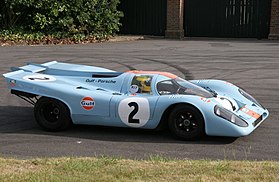| Porsche 917 | |
|---|---|
 Porsche 917K in the distinctive Gulf Oil livery at the 2006 Goodwood Festival of Speed | |
| Overview | |
| Manufacturer | Porsche AG |
| Production | 1969–1970 (917) 25 built 1970–1971 (917 K) 12 built[1] |
| Assembly | Stuttgart-Zuffenhausen, West Germany |
| Designer | Helmuth Bott (chassis) Hans Mezger (engine) |
| Body and chassis | |
| Class | Racing car |
| Body style | 2-door coupé |
| Layout | Rear mid-engine, rear-wheel-drive |
| Platform | Porsche 908 |
| Doors | Dihedral doors |
| Related |
|
| Powertrain | |
| Engine |
|
| Transmission |
|
| Dimensions | |
| Wheelbase | 2,300 mm (90.6 in)[1] |
| Length | 4,780 mm (188.2 in)[1] 4,120 mm (162.2 in) (917 K) |
| Width | 2,033 mm (80.0 in)[1] 1,980 mm (78.0 in) (917 K) |
| Height | 920 mm (36.2 in)[1] 940 mm (37.0 in) (917 K) |
| Kerb weight | 820 kg (1,808 lb)[1] |
| Chronology | |
| Predecessor | Porsche 907 |
| Successor | Porsche 936 |
The Porsche 917 is a sports prototype race car developed by German manufacturer Porsche to exploit the regulations regarding the construction of 5-litre sports cars. Powered by a Type 912 flat-12 engine which was progressively enlarged from 4.5 to 5.0 litres, the 917 was introduced in 1969 and initially proved unwieldy on the race track but continuous development improved the handling and it went on to dominate sports-car racing in 1970 and 1971. In 1970 it gave Porsche its first overall win at the 24 Hours of Le Mans, a feat it would repeat in 1971. It would be chiefly responsible for Porsche winning the International Championship for Makes in 1970 and 1971. Porsche went on to develop the 917 for Can-Am racing, culminating in the twin-turbocharged 917/30 which was even more dominant in the role. Porsche drivers would win the Can-Am championship in 1972 and 1973. 917 drivers also won the Interserie championship every year from 1969 to 1975.
